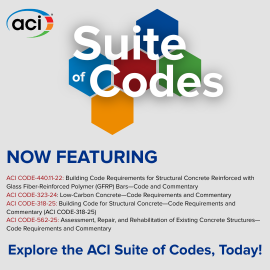
Concrete basics: Where to find the basics of code compliant concrete for large buildings
Chapter 19 of the International Building Code reveals a trove of code-related concrete information
Due to concrete’s increased structural use in recent decades, this plastic-to-solid matter has emerged both as a topic in inspection exams and in those oh-so-many, building code passages. Architects and engineers specify it in floors, walls, foundations, single and multifamily dwellings, big box and high-rise buildings, parking garages, retaining and sea walls, swimming pools, stadiums, and hundreds of other construction products. Based on weight, it ranks as the world’s most utilized, man-made substance.
Where can a building official or other interested party find the basics of code-compliant concrete for large buildings? I suggest you start with the International Building Code (IBC) and then move on to two other sources.
The entire Chapter 19 (Concrete) of the IBC Code and Commentary reveals a trove of code-related concrete information. For example, the commentary of Section 1903 offers over five pages of information. It’s amazing stuff, and you will see data on types of cement, aggregates, water, steel reinforcement, and admixtures. If I put a name to Chapter 19, I would call it, “Concrete, Ground Zero.”
Going a tad beyond the basics, Section 1705.3 explains the situations that require special concrete inspection, and Table 1705.3 specifies which inspections are periodic and which are continuous.
As for the additional sources, the commentary of Section 1901.1 literally screams at building inspectors to get and read a copy of the Concrete Inspection Handbook by the Portland Cement Association. The second reference, ACI 318, Building Code Requirements for Structural Concrete and Commentary, appears nearly everywhere in Chapter 19 of the IBC. An inspector should label the handbook and the ACI 318 “must have” documents. (ACI is the acronym for the American Concrete Institute). Given the volume of concrete poured within your boundaries, you need a copy of each.
The inspection handbook discusses the five types of Portland cement and their characteristics. It also provides a dialogue on the three widely used, “day of the pour” concrete tests: the slump, the compression (cylinder), and the air test. The slump test shows the concrete’s workability. As for the compressive strength, the field tester casts the cylinders in sets of three, four, or five. These then go to a certified testing lab where other technicians break them, at seven and twenty-eight days, using calibrated machines to measure the compressive strength. Some jobs also specify a three-day break to get an earlier look at the numbers. The third, the air test, provides the air content for durability purposes. You will also find detailed guidelines on how to perform the three tests, along with drawings of the equipment and the various ASTM standards used for the tests.
In the handbook, you will also spot photos and sketches of a slump test and of steel reinforcing called rebar (size, shape, identification, and how to install). The book also discusses chemicals called admixtures used to add strength or to slow or speed up curing hot and cold weather concreting, durability, post-pour testing (the Windsor Probe, the Schmidt Rebound Hammer the pull-out test, and coring), installing and removing formwork, and special inspections.
ACI 318 contains most of the information found in the handbook but in greater detail. It also adds a chapter on seismic design, along with various explanations of strength, flexure loads, and shear and torsion, and includes engineering formulas.
Next, I advise you to visit a job site or two during a concrete pour. Focus on the technician. He or she will likely do the aforementioned tests. If possible, follow your site visit with a tour of a licensed concrete testing lab in your region. The lab has a room or area that contains the stored cylinders taken from the job site. If your timing is good, you may get to see a few cylinder breaks.
When you have done these field exercises and asked at least three logical questions, as they say in the army, you have passed your basic training (in this case, for concrete).
Does your state or jurisdiction require a license for concrete testers? Massachusetts does, and for the licensing, it defers to the ACI. Go to concrete.org., the ACI website. There, click “Verify a certification.” This link will provide you with a license look-up for all certified testers in the USA. The name of the concrete licensee you want to confirm should appear on the test report.
In good economic times, companies sometimes lack the needed number of licensed testers. A couple of times each year, I have found an unlicensed tester on a job. I report this to the project manager. I tell him or her that to perform the tests in my state, all unlicensed testers must be overseen by a licensed person. In each case, by the next day, only licensed testers have done the work.
Architects and professional engineers generally specify one set of cylinders for each pour, including a set for every additional 50 cubic yards. You may wish to discuss this when the design professional submits his or her statement of special inspections.
Tell the permit holder, project manager, or both, to please add you to the list of people to get the concrete break reports when the testing lab sends them. If you are the department head, you may request adding one or more of your field inspectors to the distribution. As a rule, the results promptly arrive.
The test break report identifies the date of the pour, air and concrete temperatures, air content, type of aggregate, specified psi, and compressive strength after seven and twenty-eight days. While each of these is important, the compressive strength trumps the rest.
At a prominent place in the report, you will find the desired specification of compressive strength in pounds per square inch. On a standard concrete batch–excluding extreme weather conditions, special mixes or admixtures, if you see at least 65 percent psi for the seven-day break, the specified design mix is on target.
Of course, the best education often happens at a pour when holding the end of the truck’s chute, keeping the wire mesh in place, or adding a brace to a form. But learning takes many avenues. In this case, I believe Chapter 19 of the IBC, The Concrete Inspection Handbook, and the ACI 318 provide lots of first-rate, concrete basics.






